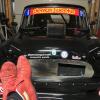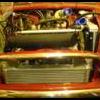Rolling Resistance
#1

Posted 17 January 2022 - 07:15 PM
Eg: 10"x165x70.. 12"x165x70.. 13x175x50"
A horsepower loss calculator would be good too if such a thing exists?
#2

Posted 17 January 2022 - 07:29 PM
Not that I have seen. But the 10 and 12s would be similar and the 13 higher.
as the 10s and 12s have basically the same OD (depends on the actual tyres bought) the attack (I forget the correct term) angle will be the same and the width again about the same.
the 13s being wider will drag more.
but then you need to think about sidewalls.
then what tyres are available. And then what compounds.
#3

Posted 17 January 2022 - 08:14 PM
#4

Posted 17 January 2022 - 09:51 PM
Flex. Heat. Tread contact with the ground as the car moves.
but much depends on application. And in just about every one it says 10” diameter wheels. Width can vary a bit.
the track 12” from Nankang is rather good from what I here.
#5

Posted 18 January 2022 - 11:57 AM
theres sooo much that affects this it would be very vey hard to calculate a reliable figure,
Surface type, Contact patch area, Rubber type, temerature, tyre pressure, side wall flex will all play a part.
#6

Posted 18 January 2022 - 01:42 PM
I'm sure the brains at pirelli/dunlop/Michelin know this info and how to get it.
#7

Posted 18 January 2022 - 07:15 PM
#8

Posted 18 January 2022 - 08:09 PM
Correction factors for tyres and drive train losses can be allowed for on some dynos.
The Dyno not only needs to be able to absorb the energy from the vehicle, but also need to be able to 'motor' the vehicle, that is the gearbox is slipped in to neutral and then the dyno, using an the absorber as a motor, drives the 'chassis' to measure these dead losses, usually these are an AC type absorber. By measuring these losses (preferably at different speeds), they can then be allowed for in the final figures. An estimation (that been based on a series of tests) can be included for gearbox losses, which isn't a fixed figure as it will (should !) be based on the type of gearbox and these losses vary with load and speed.
#9

Posted 05 February 2022 - 08:24 AM
Well, there is a scientific calculation for this as they test the optimal tyre pressure on road bikes for the ultimate roll. (Tyre deflection) Not sure how it would work on wider low pressure car tyres. Probably too many variables as the pressure changes as the tyre and air heats up etc.
Edited by no66, 05 February 2022 - 08:24 AM.
#10

Posted 05 February 2022 - 01:22 PM
Less rolling resistance would have knock on effects, like more throttle to reduce power & less torque reaction fed in to the body & suspension. So it'd remain complex to model. I guess, with a long enough windless, level straight you could coast to a stop and compare how far you got.
They originally stuck the HLE Metro on 135 tyres to chase better MPG.
#11

Posted 05 February 2022 - 01:25 PM
Correction factors for tyres and drive train losses can be allowed for on some dynos.
The Dyno not only needs to be able to absorb the energy from the vehicle, but also need to be able to 'motor' the vehicle, that is the gearbox is slipped in to neutral and then the dyno, using an the absorber as a motor, drives the 'chassis' to measure these dead losses, usually these are an AC type absorber. By measuring these losses (preferably at different speeds), they can then be allowed for in the final figures. An estimation (that been based on a series of tests) can be included for gearbox losses, which isn't a fixed figure as it will (should !) be based on the type of gearbox and these losses vary with load and speed.
Then spinning between 2 rollers will be a poor approximation for tyres on flat tarmac.
#12

Posted 05 February 2022 - 11:02 PM
Correction factors for tyres and drive train losses can be allowed for on some dynos.
The Dyno not only needs to be able to absorb the energy from the vehicle, but also need to be able to 'motor' the vehicle, that is the gearbox is slipped in to neutral and then the dyno, using an the absorber as a motor, drives the 'chassis' to measure these dead losses, usually these are an AC type absorber. By measuring these losses (preferably at different speeds), they can then be allowed for in the final figures. An estimation (that been based on a series of tests) can be included for gearbox losses, which isn't a fixed figure as it will (should !) be based on the type of gearbox and these losses vary with load and speed.
Then spinning between 2 rollers will be a poor approximation for tyres on flat tarmac.
It can be. The Dynos I've come across that have had this facility give fairly specific instructions on tyre pressures, that's based on the size and type of tyre along with how tight to pull down on the straps. I found them to be quite repeatable in their results and surprisingly good in their actual results.
1 user(s) are reading this topic
0 members, 1 guests, 0 anonymous users

















